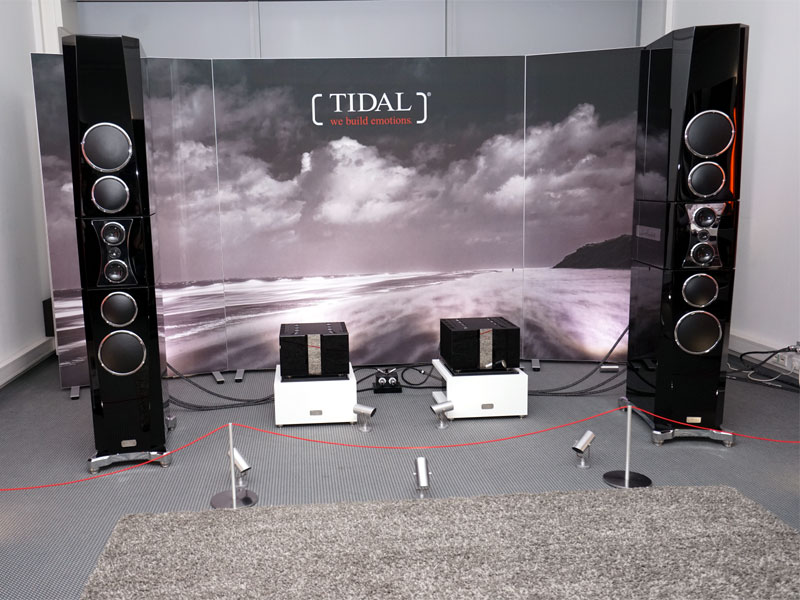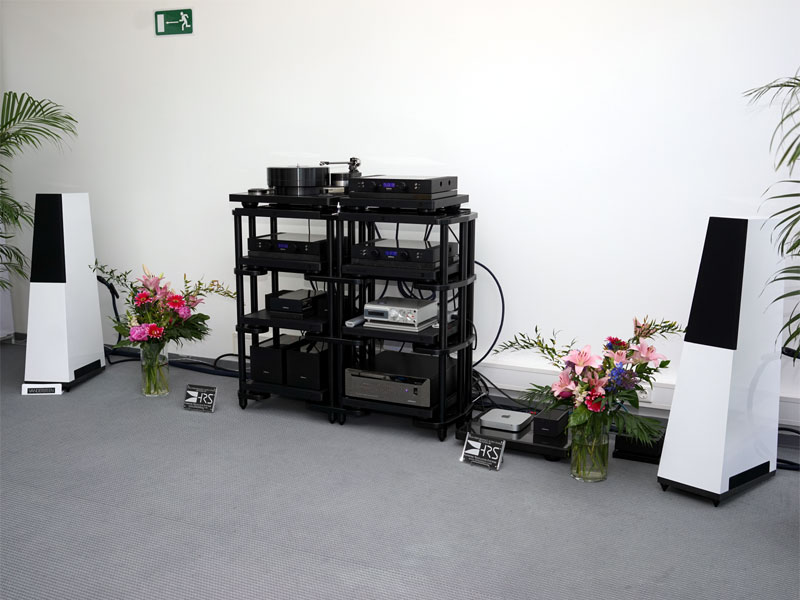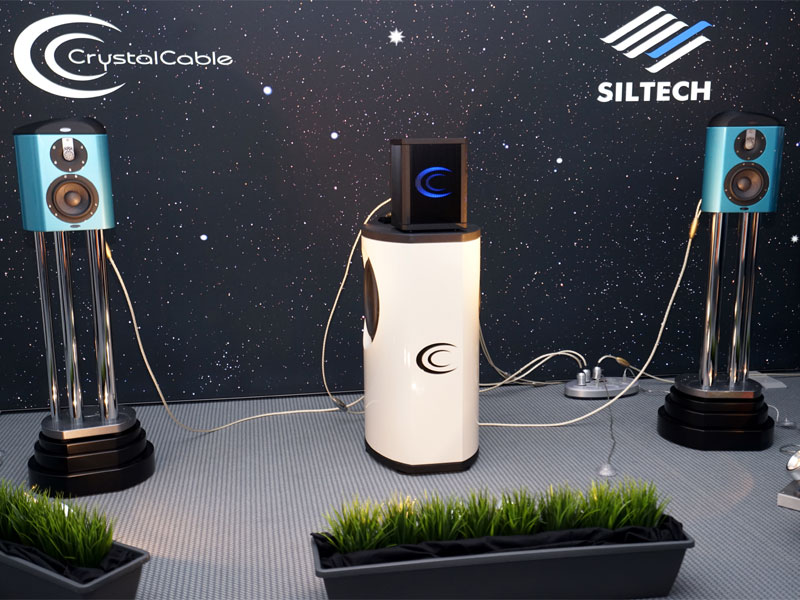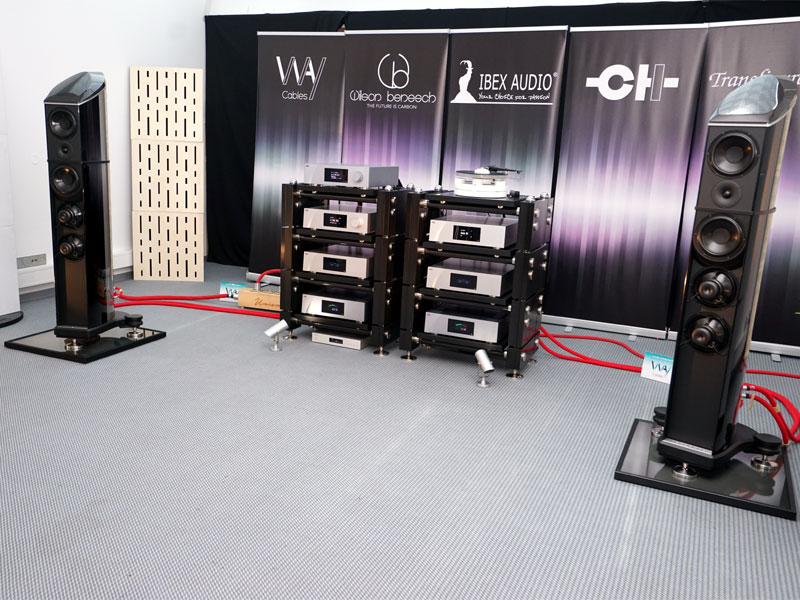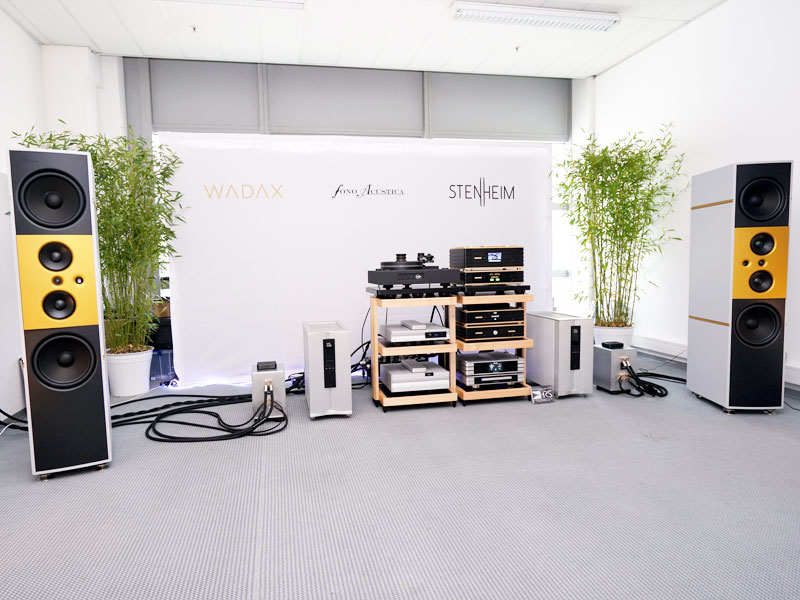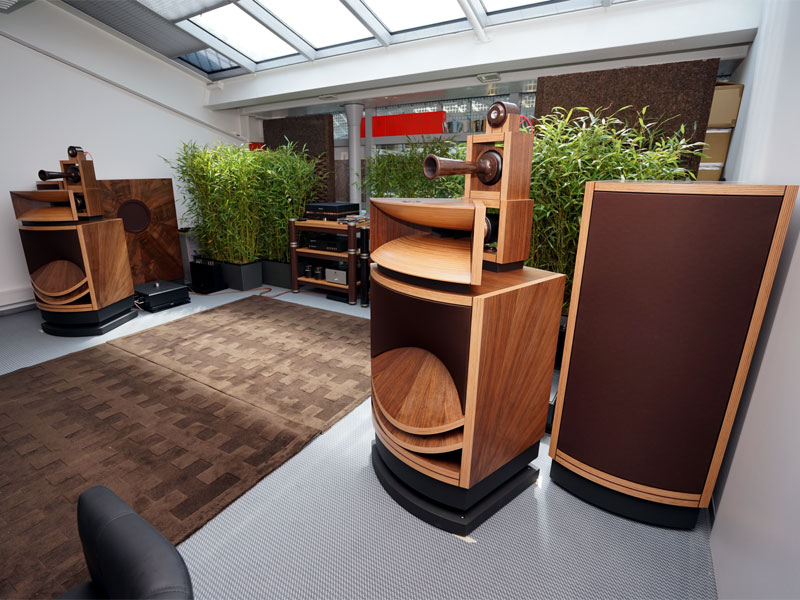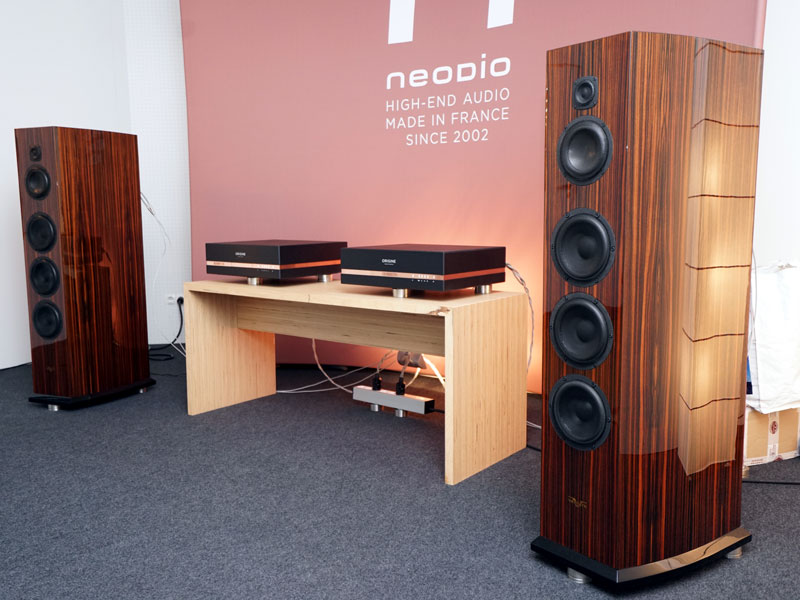High End 2017 • Payback!
or years, people have been describing the High End show in Munich as the best place in the world to see hi-fi, just not the best place to hear it. Given the light, airy nature of the MOC's atria, the copious onsite catering and meeting facilities and the sheer scale of the event, this was an obvious conclusion to reach -- especially as exhibitors have been bemoaning the impossibility of producing good sound in the exhibition rooms, blaming everything from the extensive glazing to the sloping/flat ceilings (delete as appropriate), and the partition walls to the air conditioning and AC supply. They have a point -- several, in fact. Yet, year in and year out, there have always been great-sounding systems in Munich -- more often than not, the same exhibitors conquering the challenges and proving the lie. It seems you can make great sound in Munich, as long as you have the skills and you put in the effort -- until this year, that is. For whatever reasons, even many of the most reliable exhibitors misfired, and lousy sound abounded, the screeching highs and ponderous bass, the bleached tonality, and the louder instruments leaping forward in the soundstage, all a cliché of bad audio performance. This year, it seems, the venue bit back -- with a vengeance. Yet, attendance was outstanding and the corridors were packed with overseas distributors, dealers and the public alike. The organizer's figures include over 8000 trade visitors, 541 accredited members of the press and 13,400 members of the public attending, while warm, sunny weather brought a holiday atmosphere. Yet, for all that, the show felt strangely flat. It wasn’t just the generally poor sound. Transit damage was a recurring theme, as were organizational snafus; many of the most interesting exhibits had been widely trailed in advance, robbing the event of novelty and, on top of that, there was a generally guarded underlying attitude to business, an air of economic uncertainty as a result of recent, wider events. As such, even the sporadic gushes of enthusiasm from irrepressible exhibitors somehow suggested something of the fire’s final flaring laced with desperation. Am I making too much of what is, after all, simply an impression of the event’s overall atmosphere? Possibly, but the normal round of in-show and after-hours encounters with fellow members of the press were universally downbeat, with people struggling to find anything they felt that sounded good and precious little that was of genuine interest. It’s an impression that has persisted and one that is reflected in the shorter-than-normal length of this report.
One product that was always going to attract my attention was Tidal’s La Assoluta speaker ($550,000/pair). Not only does the company have the habit of their systems sounding good by the end of the show, but two years ago the La Assolutas’ smaller brothers, the Akiras ($215,000), sounded spectacularly good. Add to that the fact that I’ve been waiting a while to hear the flagship -- and the challenge that presenting such a speaker poses -- and I made sure that the Tidal room was pretty much my last port of call on Sunday afternoon. While many manufacturers talk about cost-no-object products, the physical details alone put La Assoluta in a different league. The all-diamond output from 150Hz up is handled by a pair of unique, specially developed 5" diamond-diaphragm midrange units in each speaker, these flanking a 1" diamond tweeter, each array mounted in a heavily profiled, 40-pound stainless-steel baffle. Far from a "We’ve got the biggest diamond driver" marketing exercise, the development of the 5" drivers and the use of not one but two in each speaker was essential to achieving the required bandwidth and sensitivity, given the limited swept area and travel of previous diamond drivers. The massive, separate midrange enclosure is top and tailed by a pair of woofer cabinets, each with a 7 1/2" bass unit, a 10" long-throw subwoofer and two rear-facing 10" passive radiators. All wiring and many of the crossover components are silver and the cabinet is constructed from Tidal’s latest proprietary Tiralit-Ultra material. The complete system delivers an astonishing 96dB sensitivity -- a figure that Tidal insists is realistic rather than fanciful. For those who want more than the standard bass extension, there is a part-active option as well as the opportunity to add additional, active bass enclosures, creating an integrated four-box system. Of course, none of that comes cheap, but the La Assolutas’ price tag does include an astonishing range of sumptuous finishes while making the driving system look like an absolute bargain. How was it? Intriguing is the word that springs to mind. In many ways, this was a less successful system and delivered lower overall musical performance than the less demanding Akiras achieved previously, despite a setup featuring Tidal’s new Ferios monoblocks ($67,900/pair) and Camira DAC ($28,500), sandwiching the established Presencio preamplifier ($77,600) as well as the addition of a Thales Simplicity II turntable ($14,500; Thales tonearm, $9200; EMT cartridge, $3495) to the front-end. Yet, despite that there was definitely something magically direct and uncannily natural about this system’s constituent parts. Vocals had an immediacy and articulation that were impressively communicative and convincing, whether it was Elvis Costello or Janis Joplin, and if the whole didn’t quite gel in terms of coherent staging or dynamic authority, I’d put that down to the vagaries and limitations of the show scenario -- because one thing these speakers will do is tell you what’s wrong with the setup. This might have been a long way short of La Assoluta’s best, but the potential was certainly clear, as was the no-holds-barred approach to the design. So no, La Assoluta didn’t provide a knockout sonic blow in Munich, but it did more than enough to make me want to hear it again under more controlled conditions. All indications are that this could -- some would say should -- be Tidal’s crowning glory. And the impressive performance capabilities of their more approachable products make them an enticing prospect indeed.
Another system -- albeit rather more modest -- that took its time to get going was in the Brinkmann/Vandersteen room. This would usually be an oasis of musical calm amidst the sonic mayhem of huge horns, high levels and competing audio egos, but a quick visit on day one revealed a setup that sounded disturbingly unsettled and ill at ease. The reason soon became apparent: following a trend in recent years, the intention was to downsize the system once again, this year relying on Vandersteen’s impressive (and, at $13,900/pair, impressively affordable) Quattro CT loudspeakers. The one exception to this rule was the use of the massive HRS SXR frame system, equipped with a suite of the new S1 platforms. The best-laid plans, as they say. The basic Brinkmann Bardo turntable ($7000) got bounced in transit, leaving the company having to substitute the Balance ($22,000) that had been intended for static display. No great drama, you might think, until you realize that the Balance weighs over twice as much as its baby brother and the S1 platforms are all load rated. End result was that the ‘table bottomed the suspension on the platform, at which point the massively (and I do mean "massively") heavy and rigid, solid billet-aluminum SXR frame went from being an asset to having a distinctly negative influence, delivering structure-borne energy directly to the rigid record player. The low-frequency feedback was both obvious and destructive, negating whatever positives might have been present. But this tale wasn’t all doom and gloom. Eventually a set of feet rated for the higher loading of the Balance was found and fitted, allowing the HRS rack and the turntable to perform as intended. Anybody who doubts the contribution of proper equipment supports to system performance should have heard this before and after. Likewise, anybody who doubts the musical importance of deep but properly integrated low frequencies should have experienced this change. It was an object lesson in not just proper system support, but the destructive potential of deep bass done badly -- and how to get it right. Vandersteen’s flexible active bass EQ allows really precise matching of low-end output to the acoustic space and has been a major contributor to the consistently excellent sound in this room over the years. With the system support taken care of, the Quattro CTs were able to show just what they were capable of. Driven by the Balance, a Brinkmann 12.1 tonearm ($5890) and EMT cartridge ($3990) feeding Brinkmann's Edison phono stage ($11,400), Marconi line stage ($11,400) and a pair of Mono power amps ($14,900/pair), all hooked up to an AudioQuest Niagara 7000 ($7995) with AudioQuest cabling, the speakers had a sense of substance, relaxed rhythmic integrity, space and purpose that few other systems at the MOC this year could even hint at -- despite the fact that this whole system barely met the cable budget in more than a few of those other rooms.
Crystal Cable once again showed a "small" system, based around the Minissimo Diamond speakers (€16,000/pair), CCI Cube integrated amp (€13,000) and the production version of the Subissimo subwoofer (€10,000), with filtering/crossover duties carried out by the Cube. Cabling was all Crystal Cable Absolute Dream (interconnects, €9000/meter pair) or Ultimate Dream (€11,900 per 1.5m power cord, €32,250 for a two-meter speaker cables) and the source was a dCS Rossini Player ($28,499) and Clock ($7499). This system starts to take on a jewelry-like quality, given its diminutive dimensions but substantial cost. Thankfully, the small but beautifully formed elements -- even the Subissimo manages to look far more graceful than the average subwoofer -- sound as poised and polished as they look, with a warm, sweet and inviting musical quality, redolent with natural tonal color but not short on dynamics. In fact, this system's lack of edge or glare could lull you into believing that it was sweetening and softening the sound -- right up to the point where the uninhibited weight and dynamics corrected that impression in no uncertain terms. In one sense, this Crystal Cable setup looks awfully familiar, the same basic components having featured for the last couple of Munich shows. But scratch the surface and the finished versions of both the CCI amplifier and the Subissimo have allowed full reign to the significant performance advantages offered by the Ultimate Dreams. What was always nice has taken on a new sense of steel and authority that elevates the musical performance and expressive range to a whole new level, making this one of the most elegant and discrete high-end systems around. Crystal Cable has moved one giant step closer to their avowed intent of offering audio solutions that look as good as they sound.
Another company that saw its long appreciated potential finally blossom in the show scenario was Wilson Benesch. Their new Resolution loudspeaker ($69,500/pair) shares the carbon composite/extruded aluminum structure of the Cardinal and Endeavour models that flank it in the flagship geometry series, as well as the Semisphere carbon/silk-domed tweeter and Tactic-II midrange and bass drivers. The upper and lower midrange units flank the tweeter in the same Troika arrangement that is deployed so successfully in the Cardinal, and if the floorstanding, split-cabinet construction and triangular base with its large adjustment wheels also look familiar, in this case they are far more compact, making the speaker both easier to accommodate and easier on the eye. Of course, smaller dimensions mean a smaller volume and less bandwidth or sensitivity. The Resolution uses two of the Tactic-II isobaric bass-driver pairs per cabinet, delivering a -3dB point of 30Hz balanced against a sensitivity of 90dB. But as with all Wilson Benesch designs, that last number is slightly misleading, the mechanical roll-offs built into the drivers meaning that despite the number of drive units and the complex speaker topology, the amplifier actually sees what amounts to a two-way, first-order crossover -- about as easy a load as it gets. Having said that, there’s no escaping the fact that whilst they don’t need a lot of power, Wilson Benesch speakers certainly like it. The Resolution seems to be no exception, and the show system featured a pair of CH Precision A1 amplifiers (€28,900 each) running in mono and an L1 line stage (€23,900) complete with X1 power supply (€14,500). The digital front-end was a C1 DAC (€24,900) being fed by a Melco streamer, but I chose to listen to the Wilson Benesch Circle turntable, the 25th-anniversary model fitted with a Nanotube tonearm ($8350) and Transfiguration Proteus Diamond cartridge ($10,000). The system was cabled with solid-core silver Way cables and was supported on a Wilson Benesch R1 rack system, with prices starting at $8500 per level. This comprehensive approach certainly paid off, with the system throwing a notably coherent and spacious soundstage that stepped well away from the speakers, standing like silent monoliths and guarding the outer extremities of the stage’s proscenium arch. Individual images were solid, compact and convincingly scaled and dimensioned within the stage, delivering a real sense of the relationship between instrumental voices within the same performance. Playing the Karelia finale (from the RCA Gibson/Sibelius 5 record), the sense of energy and musical intent brought an impressive urgency and vigor to the performance, while the rich colors and apparently unlimited headroom delivered substance, dynamic swings and drama a plenty, the brilliant brass tuttis punching through with an effortlessly natural grace. Playing the more contemplative Fifth Symphony, I was impressed by the natural sense of musical flow and pacing, the tactile quality, pitch and tone-on pizzicato bass sections. This system was able to deliver both the space and structure within this complex music, the sparse opening of the second movement a particularly stern test of temporal and rhythmic coherence that was passed with flying colors. Just as impressive, shifting the musical ground to Nick Cave did nothing to trip the system’s sense of confidence or diminish its communicative qualities, and I suspect that this is one speaker around which it’s possible to build a truly balanced system -- one that will play all music without fear or favor. While I don’t want to discount the role played by the CH Precision electronics in this setup, especially the L1 line stage, a unit so often absent from previous Wilson Benesch-based systems, it was almost inevitably the loudspeakers that were the star of this particular show. The Resolution might be a smaller design than the Cardinal, but it speaks with a voice that’s just as commanding, and it will do so in a far wider range of rooms. Its more accessible pricing, more attractive proportions, range of cost/finish options and readily accessible performance will make it a lot of friends, while the opportunity to augment its low-frequency output with the Torus sub-bass system ($12,500) adds another level of versatility to what is already a highly adaptable design. Nailing the sweet spot between technology, price, performance and appearance, this could just be a breakthrough product for Wilson Benesch in a number of key markets, not least the US and Far East.
Another room in which a big system sang was the shared space occupied by Wadax, Fono Acustica and Stenheim. Of course, the sheer quality of the participating products helped, as did the supporting role played by Kuzma ($21,999 Stabi M turntable, $8995 4Point 14 tonearm and $3199 CAR-40 cartridge), VTL ($20,000 TL-7.5 III preamplifier and $65,000 Siegfried II monoblocks) and HRS (RXR stand with M3X platforms and R-Shelves), but I suspect the magic ingredient was the inclusion of Stirling Trayle’s setup skills. Especially in a shared room, allocating system tuning to a single pair of (highly capable) hands is always a good move, and it definitely paid dividends here. The new Atlantis digital electronics from Wadax ($69,000 for the DAC, $19,000 for the streamer and $45,000 for the universal transport) have been covered elsewhere in the show report and the Fono Acustica Virtuoso cables ($9995 for the Sinfo distribution block, with cables starting at $10,900 for the digital interconnects, $13,440 for the power cords and $15,680 for interconnects) with their striking terminations are also familiar. What was new were the Stenheim Reference Ultime Passive loudspeakers ($184,500/pair plus $19,950 for the external crossovers), this version of the familiar Ultime Reference cabinets dispensing with the external active crossover and additional amplification for the bass drivers -- and saving a chunk of change along the way. Using such potent, wide-bandwidth speakers at a show is always a high-risk strategy, while eliminating the active equalization options for the low frequencies is surely the audio equivalent of doubling down on the bet, but in this case the results were a musical triumph. The transparency and control, effortless dynamics and neutrality of the VTL electronics were definitely on display, as was the natural sense of musical flow that is the Wadax signature. The Fono Acustica cables brought their expressive ease, and the HRS supports also played their part, but it was the seamless coherence of the sound as a whole that really impressed, from the sense of space and instrumental color to the emphatic weight and dynamics. Vocals were subtle and intimate, but when the music demanded scale and impact they were delivered without hesitation. This was a system to which I returned many times and it never disappointed. Wadax has long provided my own personal digital benchmark, the Kuzma and VTLs I use at home, while the Stenheim speakers manage to impress me each time I listen to them, irrespective of model or location. With so many individual elements that I rate highly, there was a serious risk that this system might fall seriously flat. That it didn’t is testament to both the tractable nature of the products in play and the skills of the guiding hand resting on the tiller. Which brings me to what were the best-sounding and most musically satisfying rooms at the show. But first a short digression: each show seems to breed its own "disc of the moment," an LP or CD that somehow happens to be the right piece in the right place at just the right time. This year in Munich that disc was Lisa Batiashvili’s recent recording of the Sibelius and Tchaikovsky Violin Concertos on DGG with Barenboim and the Staatskapelle Berlin. Batiashvili is fast becoming my favorite live performer when it comes to violinists, and I bought this disc as soon as it appeared, anxious to hear what she could do with the Sibelius: after all, who needs another Tchaikovsky? So imagine my surprise when "dull Daniel" turned in a storming and beautifully poised reading of the aged Russian potboiler, ably supporting a scintillating performance by the soloist. Sound quality is good if not of audiophile quality -- but the playing is to die for. With so many systems at the show coming up short, this disc soon became the acid test, its combination of drama, scale, explosive dynamics and emotional range delivering an instant pass/fail judgment of unflinching accuracy, ruthlessly exposing discontinuities, non-linearities, overblown bass, or any lack of clarity, immediacy or musical communication. Very few systems survived the experience, but one that did was the Neodio/Kondo/Living Voice Vox Palladian/Palladian Basso setup, another variation on what has become a familiar theme. In fact, so successfully did the Living Voice rig deliver Ms. Batiashvili’s finest moment that at the end of the 20-some minutes of the opening movement the audience broke into spontaneous applause. In terms of what that says about this system’s musical communication and honesty, that is seriously impressive.
This year, the Living Voice setup consisted of a Neodio Origine S2 CD player (€39,000), a Kondo M77 preamplifier (£40,000) and Gaku-Oh push-pull monoblocks (£70,000/pair and and fitted with Living Voice’s own 300B-LV tubes, £900/pair) driving the Vox Palladian four-way composite horns, underpinned by the finalized Palladian Basso horn-loaded subwoofers (£450,000 for the four-box system in the walnut finish). The racks were the new Living Voice G3 (£16,000 each), all cabling was by Kondo and, as usual, the whole system was run from a dedicated battery supply and parallel inverters, the Living Voice Pure Music Power Supply (£25,000). This creates a dedicated 24V supply that will run the show system for a whole day with only 18% depletion. That really is going the extra mile. As already described, the sound had the scale, articulation, dynamic coherence and tonal grace to convince, communicating both the thunder and the nuance in a performance with equal ease. The sense of human agency was never in question, whether the material being played was classical, jazz or Scandi electro-fusion, the purpose of the performance never in doubt. Once again, Kevin Scott has brought a massive, demanding and eye-wateringly expensive system to the MOC -- and made music that’s worth every penny that system costs. It’s an extraordinary performance -- both from the man and the products he builds and represents. Which brings me to an inevitable conclusion: after half a decade of best-sound accolades, it’s time to give Living Voice a Lifetime Achievement Award -- thus giving somebody else a chance and meaning that I don’t have to keep writing up what is very nearly the same system year in, year out. But make no mistake -- this is no empty gesture. The sentiment is very real indeed. Living Voice has been setting the bar for years; it’s time to acknowledge the consistent excellence that underpins that achievement -- and at the same time see who’s going to step up to the plate. In the meantime, you owe it to yourself to hear this system -- in whatever guise it takes. It is both a remarkable musical experience and the very essence of what high-end audio ought to be about. So, with the field cleared, who stepped forward to take the laurels this year?
The sound that most impressed me, for its clarity of musical purpose and the direct immediacy of its presentation was to be found not in one of the large atrium rooms, but rather in one of the prefabricated cabins that are scattered across the main halls. Tucked away on the far wall of Hall 1, Neodio were presenting their simple, incredibly elegant and accomplished Origine S2 CD player (€39,000) and recently finalized A2 amplifier (€39,000). Speakers were Venture Audio Ultimates (€78,000/pair), but what made this system special, both conceptually and, I suspect, musically, was that it represented an entire Neodio ecosystem. Cables were all from the Origine stable, with Origine I3 interconnects (€990/pair) P5 power cords (€1090 each) and L0 loudspeaker cables (€1590/three-meter pair), while both electronics and speakers (and even the display screen behind the system) were supported on Origine B1 feet (€1000 for a set of four). Whilst the nature of the room prevented the generation of any real deep bass, this was the only system at the show (besides the Living Voice) that presented the sheer brilliance and sensitivity of Batiashvili’s playing. The poise, grace and agility of her bowing, the emotional intensity she brings to those familiar lines and phrases were captivating, and this was another room in which I played the whole first movement. Despite its explicit clarity, the sound was neither etched nor obvious. Instead, the spatial and dynamic coherence ensured that the performance made perfect sense, with an unforced sense of flow and pace allowing the solo instrument to set its own tempo and lead the conversation with the orchestra.  At no time did I find myself listening to the system, irrespective of what I
played -- and I played quite a variety of music, embracing everything from Ennio Morricone
through Janis Ian to Christina Pluhar playing Purcell. On every genre, no matter the scale
or nature of the recording, this system excelled. Is it a coincidence that the Neodio
Origine S2 was fronting the Living Voice system too? I don’t think so. It’s
about time people stopped looking askance at this one-box player with its CD-only
transport and recognized it for what it is: one of the finest and most musically
satisfying digital front-ends currently available. Take the whole Neodio approach to its
logical extreme and the results are as astonishing in audio terms as they are musically
satisfying. If less really is more, then Neodio is definitely delivering the most from the
least -- in terms of boxes if nothing else. At no time did I find myself listening to the system, irrespective of what I
played -- and I played quite a variety of music, embracing everything from Ennio Morricone
through Janis Ian to Christina Pluhar playing Purcell. On every genre, no matter the scale
or nature of the recording, this system excelled. Is it a coincidence that the Neodio
Origine S2 was fronting the Living Voice system too? I don’t think so. It’s
about time people stopped looking askance at this one-box player with its CD-only
transport and recognized it for what it is: one of the finest and most musically
satisfying digital front-ends currently available. Take the whole Neodio approach to its
logical extreme and the results are as astonishing in audio terms as they are musically
satisfying. If less really is more, then Neodio is definitely delivering the most from the
least -- in terms of boxes if nothing else.
Which brings me finally, inevitably, to this year’s Duck For Cover Award. With so many underperforming (and seriously expensive) systems on show, I really was spoilt for choice, but that situation leads me to its own, equally inevitable conclusion. This year’s DFCA goes to the MOC, the exhibition venue that finally got even. |

